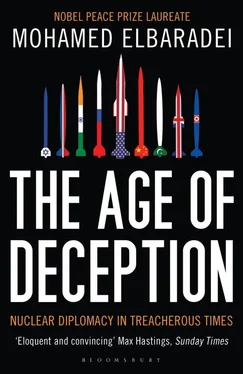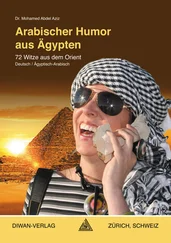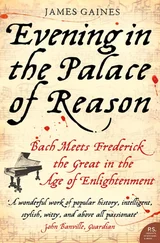The Iranians submitted their response, as scheduled, on August 22. They had accepted some but not all of my advice. The twenty-one-page document was long and convoluted, but distilled to its essence, it included a number of positive elements. Despite Larijani’s earlier defiant public statement, the Iranians remained open to the notion of suspension, so long as it was not a precondition of negotiations. They were willing to implement the Additional Protocol on a voluntary basis during the negotiations. And they were ready to commit to permanent membership in the NPT, to allay fears of a “breakout” scenario in the style of North Korea.
The reaction was cautious. The EU-3 felt that dialogue was possible; the Russians spoke out against sanctions as a dead-end street; China advised patience. They all called or came by, as did Javier Solana and Kofi Annan, to ask what I thought of Iran’s response. But no one seemed ready to take a leadership role.
Eventually, the United States and the Europeans appointed Solana to meet with Larijani to try to determine a way forward. Larijani, however, was not too keen on the idea, since he felt that Solana did not have the authority to make decisions. He was especially set against seeing Solana together with the EU-3 representatives; he still had a sour taste in his mouth from their mid-July meeting in Brussels.
I suggested to Solana that he and Larijani meet alone to agree on a set of four principles as a framework for negotiation. The first principle: Iran would suspend enrichment during the talks. In reciprocation, as the second principle, the Europeans and Americans would suspend Security Council sanctions during this period. The third principle would affirm Iran’s right under the NPT to use nuclear energy for peaceful purposes, making clear that the suspension was not permanent. And the fourth: a statement respecting Iran’s political independence and sovereignty.
If Solana and Larijani could settle on these principles, then the foreign ministers could meet and declare them the basis for the negotiations. “Both sides would save face,” I said to Solana. Tehran could tell its domestic audience that they had accepted the suspension only for the duration of the negotiations. The United States could say they had attended the meeting knowing Iran had agreed. Rice’s attendance would be essential as an incentive for Iran.
I repeated these ideas to Larijani. He and Solana fixed a date for early September. I outlined the principles over the phone to Kofi Annan, who planned to visit Iran at about the same time. [9] Annan supported the set of principles, but his visit to Iran never materialized.
Tehran was showing restraint. The IAEA had observed no significant quantitative or qualitative expansion of Iran’s enrichment program beyond the 164 centrifuges already in place. Nuclear material was introduced only occasionally and for short periods, which was not the way to build enrichment expertise, had that been the Iranians’ objective. We could not tell whether the slow progress was due to a technical problem or a political choice. But in any case, Iran’s program was still at a rudimentary level.
On September 5, Condoleezza Rice called me to ask about the set of principles, as conveyed to her by Ambassador Schulte. “Iran cannot accept suspension as a precondition,” I explained. “They see this as political suicide. Also, they will need some sort of statement about security.”
“This sounds like what we did in North Korea,” Rice replied, seeming quite willing to consider the four principles, which was a departure from Washington’s unyielding position on Iranian enrichment. “But we will have problems with giving them any security assurances,” she said.
“Then make it a statement of good intention,” I urged her. “You can fudge it.” Rice agreed to at least take some time to mull over the principles and get back to me, but added, “You know we also cannot sit down with Iran until the suspension is in place. But perhaps,” she mused, “the Europeans—or maybe the Europeans with the Russians and the Chinese—can have a meeting with the Iranians first.” Then, after the declaration of principles and verification of the suspension, the United States could join.
As I headed off to Woodstock in Oxfordshire, England, where my daughter, Laila, was getting married, Peter Castenfelt called, asking to see me urgently. On the night before the wedding, he made his way to the hotel just as our extended family, in from Cairo, New York, and other parts of the world, was about to gather for dinner. The bride was not pleased. “He’d better have something important to tell you,” she said.
Castenfelt did more listening than talking. He had just come from Tehran the day before and wanted to know precisely what was required of the Iranians. “Could they do some version of suspension but not full suspension?” he asked.
That would not work, I said. He needed to tell the Iranians that time was running out. Without an agreement, the United States and the EU-3 would go to the Security Council to propose new sanctions on Iran for failure to adhere to the demands of Resolution 1696. “Even if they start with a mild set of sanctions,” I said, “Iran will retaliate, and that will start an uncontrolled chain reaction of retaliation, which could lead to a major confrontation, and solve nothing.” Castenfelt nodded solemnly, scribbled some notes, and took his leave.
On the following day, September 8, my daughter, Laila, married Neil Pizey, a young British man, at Blenheim Palace. For a few hours, the stresses of Vienna seemed distant. As the solemnity and beauty of the wedding ceremony unfolded, I thought of the part of my Nobel speech that had brought Laila to tears: “I have hope because of what I see in my children and some of their generation… my son and daughter are oblivious to colour and race and nationality. They see no difference between their friends Noriko, Mafupo, Justin, Saulo, and Hussam; to them, they are only fellow human beings and good friends.”
At the time, Laila had been collecting her courage to introduce me to the man she loved. Laila knew that, at some level, I had hoped she would marry an Egyptian. But as someone who daily observed the ruinous effects of cultural distrust, I blessed my daughter for her choice.
That same day, Solana and Larijani were meeting in Vienna. They spent seven hours together, and Larijani, recounting their conversation afterward, considered the meeting constructive. Suspension remained the central hurdle. Larijani was still trying to deal with the fear emanating from certain quarters in Tehran, that if Iran suspended enrichment they might face insurmountable obstacles to resuming their fuel cycle activities.
As one option, I suggested grouping the discussion of suspension with other topics, such as the other six countries’ commitments to providing power reactors and respecting Iran’s NPT rights, so that suspension would not stand out as a solo item. “Perhaps you do not even have to declare it,” I told him. “It might be enough to stop enrichment activities, de facto, and I could report the suspension.”
Larijani mumbled something about suspension as a gentleman’s agreement or staggering it over a period of time. Clearly, he was frustrated, trying to find any creative way possible to achieve a solution. Much of this he said he had talked over with Solana.
On one point, Larijani had been quite firm: any future decision to “certify” Iran as qualified to resume fuel cycle activities would be solely a technical judgment, made by the IAEA. The European offer had intimated that the parties to the negotiation would also have a political say in determining whether Iran had achieved the needed level of confidence. Larijani was unequivocal: that was not acceptable. However, Iran was, as Larajani reported, willing to discuss regional issues such as Iraq, Afghanistan, and Lebanon, something the Europeans clearly wanted to do.
Читать дальше












